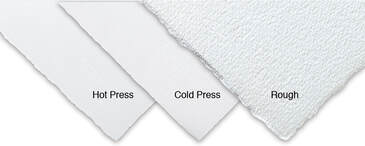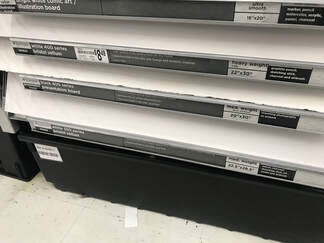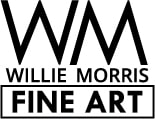 In this month's blog, you will learn about to choose which paper is best for your drawing and painting needs. With so many brands of drawing and watercolor papers on the shelves of your local art stores, choosing the right paper to get started can be a daunting challenge. So the big question, how do I choose the right paper for my idea? Rather you are a beginner or a professional, papers will come in different forms, qualities, surfaces, and weights. Each will respond differently to the paints or pencils you choose as well as to various painting techniques. Here are several things to consider that I use to help you narrow down the confusion, and get you started with drawing or painting your subject matter. So lets start with watercolor paper. HOT PRESS AND COLD PRESS PAPER Hot press is super smooth and has no texture. This paper is less absorbent than cold press. Because it doesn’t suck up the water as fast as the cold press, it allows you to play around more, like re-wetting edges of pigment. Cold press watercolor paper has texture and is more absorbent than hot press. This means you have slightly less time to move the paint around the surface before the pigments fix to the paper. Colors are less rich and slightly paler when using cold press paper. Cold press is a good choice when you want to convey texture in your subject. The texture of the paper itself adds to the aesthetic appeal of the final painting. Paint pigments settle and dry in the grooves and less on the ridges of the paper, revealing the texture of the paper, and contributing to the appearance of the finished artwork. Weight and Thickness As you probably know, watercolor paper is available in different thicknesses. Thickness is indicated by the weight of the paper. The weight is labeled as gsm or g/m2 or lb. GSM refers to grams per square meter and is a more recent and more accurate measure of the weight and thickness of watercolor paper. So, logically, the greater the weight, the thicker the sheet. Typically when you go to the local art store, they only sell the standard weights of paper such as 90 lb (190 gsm), 140 lb (300 gsm), and 300 lb (638 gsm). My preference is 300 lbs for my watercolors. Experiment with different weights to see what works best for your idea. DRAWING PAPERS & BOARDS  Now lets briefly talk about drawing and board papers. Drawing paper is ideal for sketching, and the medium surface is perfect for illustrations and final drawings. They can be purchased as a wire-bound pad, sheets or boards, suitable for any dry media, including graphite and colored pencil, charcoal, sketching stick, pen and ink, as well as marker, mixed media and pastels. The selection of paper for shading techniques is influenced by the type of pencil used, the degree of darkness desired, the shading technique used, and the expression of the shading technique desired. The key is to select a paper surface (medium or smooth) based upon the effects you’re looking to achieve. As a general rule, a medium or textured surface will be able to produce a more even, luminescent shade than a smooth surface. I only use strathmore 300 Series Bristol boards (shown above) for all of my drawing because of it smooth texture grain. Textured vs Smooth Surface Paper The smoother the paper grain the more difficult it will be to produce an even shade. Smooth paper surface cannot produce as great a range of tone (shade) as textured surface papers. Textured paper surfaces are usually chosen for shading as the texture of the paper makes shading easier and produces a greater range of tone that can be more evenly applied. Strathmore Textured Papers The higher the grade of textured paper surfaces the deeper and more even the resulting shading will be. While all Strathmore Series – 200, 300, 400 and 500 will produce even, deep, luminescent shades, the 500 papers will produce the richest and deepest shade. I hope this was very helpful in making your selection with the many different brands of watercolors. Until next time, be creative in all that you do!
0 Comments
Leave a Reply. |
welcomeHello and welcome to my blog. Here I will share videos of projects, lessons, stories, upcoming events, and sites of use, Archives
July 2020
Categories |
Copyright © 2023 | williemorrisfineart.com | Contact Us

 RSS Feed
RSS Feed